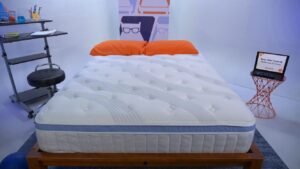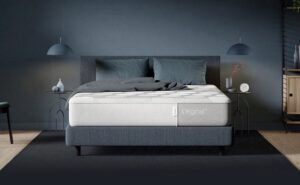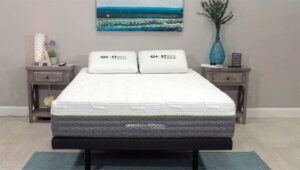What are Hybrid Mattresses?
Disclosure: By clicking on the product links in this article, Mattress Nerd may receive a commission fee at no cost to you, the reader. Read full disclosure statement.
Mattresses can be grouped into various categories. There’s all foam, classic innerspring, and hybrid. Hybrid mattresses combine features of both foam and innerspring mattresses into one. That blending of comfort and support makes hybrid mattresses well-suited to a wide range of sleepers.
Components of a Hybrid Mattress
Hybrid mattresses combine comfort materials with supportive coils. Both the materials used and the number of layers can vary, but the general construction looks like this:
- Comfort layers. These uppermost layers are typically made with memory foam, polyurethane foam, latex, and wool. The choice of material in these layers will dictate how a mattress will feel and respond.
- Support layers. The layers at the bottom of a hybrid mattress give it structure, support, and durability. Dense foams may be used, along with a layer of individually wrapped (i.e. pocketed) coils that move independently to support the body in various positions. This coil layer also encourages air circulation, making hybrid mattresses more breathable than all-foam constructions.
- Transition layers. Typically, hybrid mattresses also include a dense transition layer that serves as a cushioning barrier between the lower support layers below and the comfort layers above.
Depending on a sleeper’s personal preferences, sleep style, and body type, the combination of specific materials in the comfort materials above the innerspring layer can make for a great night’s sleep. For example, our Nerd’s Pick of the best hybrid mattresses of 2025 is the Saatva Classic, which combines memory foam and polyurethane foam with a generous layer of durable steel coils. It comes in a choice of three firmnesses to suit different comfort preferences, and the material combination makes for a durable, comfortable sleep surface with excellent edge control.
Like other mattress constructions, hybrids can be designed to resolve specific sleep concerns. If you’re prone to overheating at night, you can look for hybrid mattresses made with cooling foams or temperature-regulating latex. Looking for pressure relief or motion isolation, love feeling hugged by your mattress, or prefer non-toxic, eco-friendly materials? There’s a hybrid mattress for that, too.
Pros of Hybrid Mattresses
- Contouring, pressure-relieving, and cooling. Depending on the materials in the comfort layers, hybrid mattresses can help address and resolve specific sleep concerns. That makes them really versatile.
- Impressive support. The combination of comfort layers and coils makes hybrid mattresses an excellent option for deep support all the way to the edge. That makes them a good choice for people who like to maximize their sleep space or need a little support getting in and out of bed.
- Responsiveness. The choice of comfort material will affect how responsive a specific hybrid mattress is, but the innerspring layer does make them a little bouncier and quicker to respond than all-foam options.
- Quiet. Traditional innerspring mattresses can be squeaky, but the thick comfort layers in a hybrid help dampen sound. While they may be a touch noisier than all-foam mattresses, they shouldn’t be too disruptive.
Cons of Hybrid Mattresses
- Higher price tag. Generally, you’ll spend more on a hybrid mattress than you will on an all-foam or traditional innerspring. However, the durability of a hybrid often outmatches other mattress constructions, so you may save money in the long run.
- Heavier weight. All of those layers can make hybrid mattresses surprisingly heavy, which can be cumbersome if you need to move it or just when you’re lifting the corners to change the sheets.
- Overwhelming options. There are a lot of hybrid mattresses on the market, so it can feel overwhelming to try to figure out which features and benefits you need.
Which Sleepers Should Choose a Hybrid Mattress?
Hybrid mattresses come in a huge range of options, so there’s a good option for just about every sleeper. If you’ve slept on both all-foam and traditional innerspring mattresses and you find them lacking in some way–too firm, too soft, too hot, not supportive enough, or you feel like you sink in too far– you should take a closer look at all the benefits a hybrid mattress has to offer. This kind of construction may also be a good option if you’re looking for something a little more responsive or you find that you routinely wake up with aches and pains.
One caveat–sleepers who like the feel of innerspring or all-foam mattresses may want to avoid hybrids simply because they tend to be more expensive. Why pay more for features you don’t need if you’re already sleeping well on a different mattress construction?
How Hybrid Mattresses Compare to Other Beds
Hybrid mattresses are a popular construction for good reason. Here’s how they compare to other common constructions.
Vs. Memory Foam

Memory foam mattresses contour closely to the body with a signature “hugged” sensation. Unless they’re made with gel-infused foams or other cooling upgrades, they can retain body heat and get quite warm. A hybrid mattress will have a slightly bouncier, more responsive feel, better breathability, and a firmer feel. For the best of both worlds, look for a hybrid with memory foam in its comfort layers.
Vs. Innerspring
Classic innerspring mattresses can be noisy, quite bouncy, and lacking in contouring or pressure relief. A hybrid mattress tends to have a softer feel with more gentle support. However, they’ll sleep a little warmer thanks to those comfort layers, with a little less bounce and noise. You’ll also get far better motion isolation in a hybrid than an innerspring, since the comfort layer materials can help minimize motion transfer.
Frequently Asked Questions
What are the negatives of a hybrid mattress?
There are a lot of upsides to a hybrid mattress, but you should expect to pay more for those benefits. Plus, all of those comfort, support, and transition layers make them a lot heavier than other mattress constructions. Hybrid mattresses come in a dizzying choice of options too, so it can feel a little overwhelming trying to drill down to the features you need most.
Do hybrid mattresses need a box spring?
In general, hybrid mattresses don’t need a box spring because the materials used in the support layer are designed for structure and support. However, the right foundation will depend on your bed frame, so make sure to check the manufacturer’s guidelines.
Is a hybrid mattress firm or soft?
It can be either! The materials used in the comfort layers of a hybrid mattress will dictate its firmness, which can vary from soft to medium to firm. If you’re looking for a specific firmness in a hybrid, you’ll be able to find it.
Takeaway
A hybrid mattress can be a great option for many different types of sleepers, with options for cooling materials, pressure relief, contouring, responsiveness, motion isolation, sustainability, and anything else you might need. However, you’ll generally spend more money than you would on other mattress constructions, which is worth keeping in mind.


